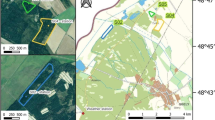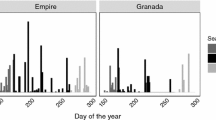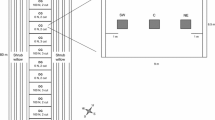Abstract
Alley cropping systems may influence soil water movement and the water budget because of its complex interactions between crop and tree rooting systems. The objective of this paper was to evaluate water balance and water competition in an alley cropping system, consisting of deciduous tree wild jujube (Choerospondias axillaris) and economic crop peanut (Arachis hypogaea) within subtropical China. Five treatments (20- by 6-m plots) with three replications were included in this study. The treatments were monoculture peanut cropping (P), monoculture younger trees (T1), monoculture older trees (T2), peanut intercropped with younger trees (T1P), and peanut intercropped with older trees (T2P). A multi-layered water balance model, with water movement between soil layers, was implemented by the measurement of soil water potential using sets of tensiometers during the periods from March 1999 to December 2002. The spatial and temporal variations of soil water regime indicated that the trees used soil water below the 60-cm soil depth and alleviated the water stress. The direction of soil water movement indicated that soil water moved to the tree row, which indicated that trees competed with peanuts for water, especially during the seasonal drought period. Water competition was related to the tree spacing and tree age. Compared to the tree monoculture systems, the alley cropping system significantly influenced water budget components and water use patterns, as indicated by the increased evapotranspiration (6–11%), and decreased net drainage (7–45%), water storage (6–29%), and runoff (50–60%). Furthermore, alley cropping systems encouraged the rapid growth of trees, and depressed the biomass and yield of peanuts by 20–50% associated with tree shading effects. The results suggest that competition for water and light must be taken into account when optimizing the alley cropping system.







Similar content being viewed by others
References
Caldwell RM, Hansen JW (1993) Simulation of multiple cropping systems with CropSys. In: Penning de Vries FWT, Teng P, Metselaar K (eds) Systems approaches for agricultural development, vol 2. Kluwer, Dordrecht, pp 397–412
Carbon BA, Bartle GA, Murray AM, Macpherson DK (1980) The distribution of root length, and the limits to flow of soil water to roots in a dry Sclerophyll forest. For Sci 26:656–664
FAO/UNESCO (1988) Soil map of the world. Revised legend. World Soil Resources Report No. 60. FAO, Rome
Feng Z, Wang X, Wu G (1993) Biomass and productivity of forest system in China. Beijing Science Press, Beijing, pp 13–14
Ghosh SP, Kumar BM, Kabeerathumma S, Nair GM (1989) Productivity, soil fertility and soil erosion under cassava-based agroforestry systems. Agrofor Syst 8:67–82
Granier A (1987) Evaluation of transpiration in a Douglas-fir stand by means of sap flow measurements. Tree Phys 3:309–320
Harr RD (1977) Water flux in soil and subsoil on a steep forested slope. J Hydrol 33:37–58
Howard SB, Ong CK, Black CR, Khan AAH (1997) Using sap flow gauges to quantify water uptake by tree roots beneath the crop rooting zone in agroforestry systems. Agrofor Syst 35:15–29
Jose S, Gillespie AR, Seifert JR, Biehle DJ (2000) Defining competition vectors in a temperate alley cropping, system in the midwestern USA, 2. Competition for water. Agrofor Syst 48:41–59
Kang BT, Wilson GF (1987) The development of alley cropping as a promising agroforestry technology. In: Steppler HA, Nair PKR (eds) Agroforestry: a decade of development. ICRAF, Nairobi, pp 227–243
Kang BT, Reynolds L, Atta-Krah AN (1990) Alley farming. Adv Agron 43:315–359
Khan AAH, Ong CK (1997) Design and calibration of tipping bucket system for field runoff and sediment quantification. J Soil Water Conserv 52(6):437–443
Kho RM (2000) A general tree-environment-crop interaction equation for predictive understanding of agroforestry systems. Agric Ecosyst Environ 80:87–100
Landsberg JJ (1986) Physiological ecology of forest production. Academic Press, Sydney, p 198
Landsberg JJ, Waring RH (1997) A generalized model of forestry productivity using simplified concepts of radiation-use efficiency, carbon balance and partitioning. Forest Ecol Manag 95:209–228
Lei Z, Yang S, Xie S (1988) Soil water dynamics. Publishing House of Tsinghua University, Beijing
Liu J, Qin T, Qiu Y (1996) Biomass and productivity of trees screened fore low hilly regions. In: The Ecological Research Station of Red Soil (ed) Red Soil ecosystem research, vol 3. China Agricultural Science & Technology Publishing House, Beijing, pp 138–143
Livesley SJ, Gregory PJ, Buresh RJ (2004) Competition in tree row agroforestry systems. 3. Soil water distribution and dynamics. Plant Soil 264:129–139
Lu P (1997) A direct method for estimating the average sap flux density using a modified Granier measuring system. Aust J Plant Physiol 24:701–705
Maraux F, Lafolie F, Bruckler L (1998) Comparison between mechanistic and functional models for estimating soil water balance: deterministic and stochastic approaches. Agric Water Manag 38:1–20
Mclntyre BD, Riha SJ, Ong CK (1997) Competition for water in a hedge-intercrop system. Field Crop Res 52:151–160
Narain P, Singh RK, Sindhwal NS, Hoshie P (1998) Agroforestry for soil and water conservation in western Himalayan valley region of India, I. Runoff, soil and nutrient loss. Agrofor Syst 39(2):175–189
Ong CK, Corlett JE, Singh RP, Black CR (1991) Above and below ground interactions in agroforestry systems. For Ecol Man 45:45–57
Ong CK, Wilson J, Deans JD, Mulayta J, Raussen T, Wajja-Musukwe N (2002) Tree–crop interactions: manipulation of water use and root function. Agric Water Manag 53:171–186
Palomo MJ, Moreno F, Fernandez JE, Diaz-Espejo A, Giron IF (2002) Determining water consumption in olive orchards using the water balance approach. Agric Water Manag 55:15–35
Puri S, Nair PKR (2004) Agroforestry research for development in India: 25 years of experiences of a national program. Agrofor Syst 61:437–452
Rao MR, Nair PK, Ong CK (1998) Biophysical interactions in tropical agroforestry systems. Agrofor Syst 38:3–50
Sanchez PA (1995) Science in agroforestry. Agrofor Syst 30:5–55
Schlegel P, Huwe B, Teixeira WG (2004) Modelling species and spacing effects on root zone water dynamics using Hydrus-2D in an Amazonian agroforestry system. Agrofor Syst 60:277–289
Singh RP, Ong CK, Saharan N (1989) Above- and below-ground interactions in alley-cropping in semi-arid India. Agrofor Syst 9:259–274
Smith M, Jackson N, Roberts J (1997) A new direction in hydraulic lift: can tree roots siphon water downwards? Agrofor Forum 8:23–25
Soares JV, Almeida AC (2001) Modeling the water balance and soil water fluxes in a fast growing Eucalyptus plantation in Brazil. J Hydrol 253:130–147
Sun G (1994) Study on water flux in soil on a forested hillslope. Chin J Ecol 13(2):36–39
Van Noordwijk M, Lusiana B (1999) WaNuLCAS, a model of water, nutrient and light capture in agroforestry systems. Agrofor Syst 43:217–242
Wang X, Zhang T, He Y, Zhang B, Wang M (2003) N recovery in Choerospondias axillaris and Peanut (Arachis hypogaea) alley cropping systems on Udic Ferrosol in subtropical China. Acta Pedol Sin 40:588–592
Wanvestraut RH, Jose S, Nair PKR, Brecke BJ (2004) Competition for water in a pecan (Carya illinoensis K. Koch)-cotton (Gossypium hirsutum L.) alley cropping system in the southern United States. Agroforest Syst 60:167–179
Wei LH, Zhang B, Wang MZ (2007) Effects of antecedent soil moisture on runoff and soil erosion in alley cropping systems. Agric Water Manag 94:54–62
Whitehead D (1998) Regulation of stomatal conductance and transpiration in forest canopies. Tree Phys 18:633–644
Willey RW, Reddy MS (1981) A field technique for separating above and below-ground interactions in intercropping: an experiment with pearl millet/groundnut. Exper Agric 17:257–264
Wu G, Li J, Deng HB (2000) Primary research on interface ecology in agroforestrial ecosystems. Chin J App1 Eco1 11(3):459–460
Xie J (1989) Survey in agroforestry. Trans Beijing For Univ 10(1):104–108
Yao XL (1995) The proceeding and prospects of research on physical properties of red soils. In: Institute of Soil Science, Academia Sinica (ed) Prof. Li Qinkui and the development of soil science of China, Sixty anniversary of Prof. Li’s involvement in soil science. Jiangsu Science and Technology Process, Nanjing, pp 57–64
Ye C, Xiong G, Huang Q, He X, Ding M (2001) Study on intercropping of Paulownia and Tea in low hilly red soil. Acta Agric Jiangxi 13(1):1–8
Yi C, Liu K, Zhou T (1996) Research on a formula of rainfall interception by vegetation. J Soil Erosion Soil Water Conserv 2(2):47–49
Zhang B, Horn R (2001) Mechanisms of aggregate stabilization of Ultisols from subtropical China. Geoderma 99:123–145
Zhang B, Zhang T (1995) Cause of seasonal drought formation and strategy of the eastern hills in southern China. Acta Ecol Sin 15(4):413–419
Zhang B, Zhang T (1997) Hydraulic ecological characteristics of alley cropping systems and its productivity in low hilly red soil region. Chin J Ecol 16(4):1–5
Zhao Y, Zhang B, Zhao HC, Wang MZ (2005) Transpiration of Choerospondias axillaris in agro-forestrial system and its affecting factors. Chin J Appl Ecol 16(11):2035–2040
Zhao Y, Zhang B, Wang MZ (2006) Assessment of competition for water, fertilizer and light between components in the alley cropping system. Acta Ecol Sin 26(6):1792–1801
Zhu QK, Zhu JZ (2003) Study on Niche of agroforesry systems in the loess Plateau. Sci Soil Water Conserv 1(1):49–52
Acknowledgments
The grants have been provided by the International Foundation of Sciences (IFS) (Grant No. D2872–1), the International Atomic Energy Association (IAEA) (Grant No. CPR-10407) and the Natural Science Foundation of China (Grant No. 49701008). Profs. Mingzhu Wang, Xingxiang Wang and Mr. Huachun Zhao are acknowledged for their involvement in this research.
Author information
Authors and Affiliations
Corresponding author
Rights and permissions
About this article
Cite this article
Zhao, Y., Zhang, B. & Hill, R. Water use assessment in alley cropping systems within subtropical China. Agroforest Syst 84, 243–259 (2012). https://doi.org/10.1007/s10457-011-9458-4
Received:
Accepted:
Published:
Issue Date:
DOI: https://doi.org/10.1007/s10457-011-9458-4




